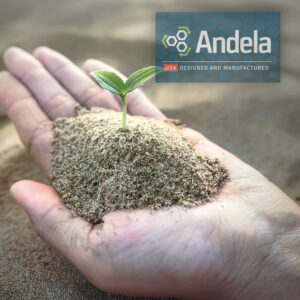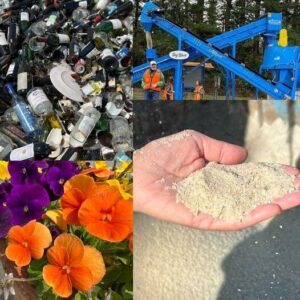Cornell University & Andela Products Research Eco-Friendly Fertilizer
 Agricultural Fertilizer: Eco-Friendly Alternative
Agricultural Fertilizer: Eco-Friendly Alternative
Teaming up with Cornell University materials science and engineering graduate student Ryan Greene, Andela Products is exploring glass sand as a potential fertilizer. Together, we crafted a process that turns waste glass into nutrient-rich silica pellets—creating a sustainable, sand-like fertilizer ready to enrich soils and reduce waste.
“Through growth study research, we found plants need the silica in the glass, using it to build sturdy stalks, especially in nightshade varieties like tomatoes. If the glass could carry and release additional nutrients gradually, we’d achieve double benefits. One major issue with fertilizers is that they often wash away too quickly, ending up in streams and eventually the ocean, causing environmental problems. Our goal was to transform waste material into a beneficial resource,” explained Cyndy Andela, President and CEO of Andela Products.
A Sustainable Solution for Nutrient-Rich Plant Growth
 The research team developed a method that used pulverized glass sand to carry fertilizer salts, binding it into pellets without adding microplastics or additional chemicals. Initially, they explored an ion exchange process to infuse plant nutrients into the glass sand at room temperature. Through trial and error, the team fine-tuned the formula and mechanical processing, producing pellets that dissolved over time in soil, while remaining stable for shipping.
The research team developed a method that used pulverized glass sand to carry fertilizer salts, binding it into pellets without adding microplastics or additional chemicals. Initially, they explored an ion exchange process to infuse plant nutrients into the glass sand at room temperature. Through trial and error, the team fine-tuned the formula and mechanical processing, producing pellets that dissolved over time in soil, while remaining stable for shipping.
To test the sand glass fertilizer prototype, researchers submerged pellets in water, observing that they dissolved completely in about 8-9 hours. For comparison, the same amount of fertilizer in its pure salt form dissolved in around 10 minutes. The sand particles essentially act as a shield for precipitates within the pellets.
Setting up a facility for pulverizing waste glass, mixing it with fertilizer salts in large water baths, and pressing it into pellets would require a capital investment. However, once operational, the facility could run with minimal expenses due to low energy demands and the availability of waste glass as raw material.
Originally reported by Nicole Imeson, an engineer and writer in Calgary, Alberta.
Read more, Cornell Chronicle.
Read more at The American Society of Mechanical Engineers: Turning Waste Glass into Sustainable Fertilizer
Interested in exploring glass sand? Contact us today.


